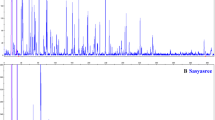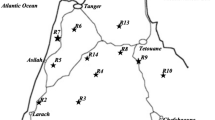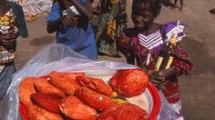Abstract
Oleander is a Mediterranean evergreen shrub found along watercourses, gravelly places and damp slopes. It is grown widely as an ornamental for its abundant and long-lasting flowering as well as its moderate hardiness. Genetic relatedness among 71 accessions, including commercial varieties, different sources of the same varieties, and selections from the wild were investigated using amplified fragment length polymorphism (AFLP). Nine primer combinations yielded a total of 603 bands of which 241 were polymorphic. Genetic similarities among accessions were calculated according to Jaccard's Similarity Index and used to construct a dendrogram based on the unweighted pair group method using arithmetic averages. Our results show that the AFLP technique, which can simultaneously and assay a large number of loci randomly distributed in the genome, is much more informative on the genetic relationship and origin of accessions than the limited number of morphological characters conventionally used for variety discrimination. Up to about 9% molecular genetic differentiation was detected among morphologically indistinguishable provenances of the same variety; this can be partly attributed to scoring error but mainly to somatic variation occurring during vegetative propagation. On the other hand lower genetic distance values were sometimes found among varieties which differ in morphological characters and are thus commercialised with different names. The possibility of considering the amount of genetic variation within a variety as the threshold value for discrimination of initial varieties and essentially derived varieties is discussed.
Similar content being viewed by others
References
Anderson, J.A., G.A. Churchill, J.E. Autrique, M.E. Sorells & S.D. Tanksley, 1993. Optimizing parental selection for genetic-linkage maps. Genome 36(1): 181–186.
Barcaccia, G., E. Alberini & M. Falcinelli, 1999. AFLP finger-printing in Pelargonium peltatum: its development and potential in cultivar identification. Journal of Horticultural Science & Biotechnology 74(2): 243–250.
Bassam, B.J., G. Caetano-Anolles & P.M. Gresshoff, 1991. Fast and sensitive silver staining of DNA in polyacrylamide gels. Anal Biochem 19: 680–683.
Carr, J., M. Xu, J.W. Dudley & S.S. Korban, 2003. AFLP analysis of genetic variability in New Guinea impatiens. Theor Appl Genet 106(8): 1509–1516.
Castiglioni, P., P. Ajmone-Marsan, R. Van Wijk & M. Motto, 1999. AFLP markers in a molecular linkage map of maize: codominant scoring and linkage group distribution. Theor Appl Genet 99: 425–431.
De Riek, J., 2001. Are molecular markers strengthening plant variety registration and protection? Acta Horticulturae 552: 215–223.
Filippi, O., 1997. Guide de reconnaissance des variétés de lauriers-roses. Pépinière Filippi, Meze (France).
Font-Quer, P., 1979. Plantas Medicinales. Barcelona, Labor SA.
Hardin, J.W. & Arena J.M., 1974. Human Poisoning from Native and Cultivated Plants, 2nd edn. Kingsport, Tennessee, Duke, University Press.
Hodkinson, T.R., S.A. Renvoize, G. Ní Chonghaile, C. Stapleton & M.W. Chase, 2000. A comparison of ITS nuclear rDNA sequence data and AFLP markers for phylogenetic studies in Phyllostachys (Bambusoideae, Poaceae). J Plant Res 113: 259–269.
Hodkinson, T.R., M.W. Chase & S.A. Renvoize, 2002. Characterization of a genetic resource collection for Miscanthus (Saccharinae, Andropogoneae, Poaceae) using AFLP and ISSR PCR. Ann Botany 89: 627–636.
Huxley, A., ed-in-chief. 1992. The New Horticultural Society Dictionary of Gardening, vol. 3. London, MacMillan.
Jaccard, P., 1908. Nouvelles recherches sur la distribution florale. Bull Soc Vaudoise sci nat 44: 223–270.
Kingsbury, J.M., 1964. Poisonous Plants of the United States and Canada. Englewood Cliffs, NJ Prentice Hall.
Lampe, K.F. & M.A. McCann, 1985. AMA Handbook of Poisonous and Injurious Plants, American Medical Association, Chicago, Illinois.
Lanteri, S., I. Di Leo, L. Ledda, M.G. Mameli & E. Portis, 2001. RAPD variation within and among populations of globe artichoke cultivar 'Spinoso sardo'. Plant Breed 120: 243–246.
Lanteri, S., A. Acquadro, L. Quagliotti & E. Portis, 2003. RAPD and AFLP assessment of genetic variation in a landrace of pepper (Capsicum annuum L.), grown in North-West Italy. Genet Res Crop Evol 50(7): 723–735.
Lanteri, S., E. Saba, M. Cadinu, G.M. Mallica, L. Baghino & E. Portis, 2004. Amplified fragment length polymorphism for genetic diversity assessment in globe artichoke. Theor Appl Genet, in press.
Lenzi, A., A. Palandri, A. Bovelli & R. Tesi, 1999. L'oleandro (Nerium oleander L.) per la coltura in contenitore. Colture Protette 9: 101–112.
Lenzi, A. & R. Tesi, 2000. La collezione di oleandri del D.I.S.A.T. – Proceedings of the Congress 'Il germoplasma toscano: tutela e valorizzazione', pp. 129–136.
Leus, L., E. Demuynck & J. De Riek, 2000. Genetic diversity of a collection of rose species and cultivars evaluated by fluorescent AFLP. Med Fac Landbouww Univ Gent 65/3b: 455–459.
Lima, M.L.A., A.A.F. Garcia, K.M. Oliveira, S. Matsuoka, H. Arizono, C.L. deSouza Jr. & A.P. de Souza, 2002. Analysis of genetic similarity detected by AFLP and coefficient of parentage among genotypes of sugar cane (Saccharum spp.). Theor Appl Genet 104: 30–38.
Loh, J.P., R. Kiew, A. Kee, L.H. Gan & Y.Y. Gan, 1999. Amplified fragment length polymorphism (AFLP) provides molecular markers for the identification of Caladium bicolor cultivars. Ann Botany 84(2): 155–161.
Milbourne, D., R. Meyer, J.E. Bradshaw, E. Baird, N. Bonar, J. Provan, W. Powell & R. Waugh, 1997. Comparison of PCR-based marker systems for the analysis of genetic relationships in cultivated potato. Mol Breed 3: 127–136.
Mueller, U.G. & L. Wolfenbarger, 1999. AFLP genotyping and fingerprinting. Trends Ecol Evol 14: 389–394.
Pagen, F.J.J., 1988. Oleanders. Nerium L. and the Oleander Cultivars – Agricultural University Wageningen, The Netherlandes, pp. 113.
Pearn, J., 1987. Oleander poisoning. In: J. Covacevich, P. Davie & J. Pearn (Eds.), Toxic plants & Animals, A guide For Australia, pp. 37–49. Brisbane, Queensland Museum.
Pejic, I., P. Ajmone-Marsan, M. Morgante, V. Kozumplick, P. Castiglioni, G. Taramino & M. Motto, 1998. Comparative analysis of genetic similarity among maize inbred lines detected by RFLPs, RAPDs, SSRs and AFLPs. Theor Appl Genet 97: 1248–1255.
Powell, W., M. Morgante, C. Andre, M. Hanafey, J. Vogel, S. Tingey & A. Rafalsky, 1996. The comparison of RFLP, RAPD, AFLP and SSR (microsatellite) markers for germplasm analysis. Mol Breed 2: 225–238.
Qi, X. & P. Lindhout, 1997. Development of AFLP markers in barley. Mol Gen Genet 254: 330–336.
Reeves, G., D. Francis, M.S. Davies, H.J. Rogers & T.R. Hodkinson, 1998. Genome size is negatively correlated with altitude in natural populations of Dactylis glomerata. Ann Botany 82 (suppl A): 99–105.
Ridout, C.J. & P. Donini, 1999. Use of AFLP in cereals research. Trends Plant Sci 4: 76–79.
Rohlf, F.J., 1993. NTSYS-PC Numerical Taxonomy and Multivariate Analysis System. Version 1.80. Exeter Publ., Setauket, New Yor k.
Schvartsman, S., 1979. Plantas Venenosas. Sarvier Sao Paulo.
Shannon, C.E. & W. Weaver, 1949. The mathematical theory of communication. In: I.L. Urbana (Ed.), University of Illinois Press.
Tomkins, J.P., T.C. Wood, L.S. Barnes, A. Westman & R.A. Wing, 2001. Evaluation of genetic variation in the daylily (Hemerocallis spp.) using AFLP markers. Theor Appl Genet 102(4): 489–496.
Ude, G., M. Pillay, D. Nwakanma & A. Tenkouano, 2002. Analysis of genetic diversity and sectional relationships in Musa using AFLP markers. Theor Appl Genet 104: 1239–1245.
Van Huylenbroeck, J., E. Coart, F. Janneteau & J. De Riek, 2001. Identification of woody ornamentals by AFLP. Eucarpia Meeting – Ornamental Symposium, 'Strategies for New Ornamentals', Melle, Belgium.
Vos, P., R. Hogers, M. Bleeker, M. Reijand, T. van de Lee, M. Hornes, A. Fritjers, J. Pot, J. Paleman, M. Kuiper & M. Zabeau, 1995. AFLP: A new technique for DNA fingerprinting. Nucl Acids Res 23: 4407–4414.
Author information
Authors and Affiliations
Rights and permissions
About this article
Cite this article
Portis, E., Comino, C., Lenzi, A. et al. Amplified fragment length polymorphism for variety identification and genetic diversity assessment in oleander (Nerium oleander L.). Euphytica 136, 125–137 (2004). https://doi.org/10.1023/B:EUPH.0000030661.25909.57
Issue Date:
DOI: https://doi.org/10.1023/B:EUPH.0000030661.25909.57




